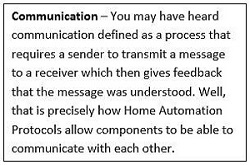

In the application of Home Automation devices and systems, it is important to understand how these items communicate both within their system, your home, and also in the big picture, through the Internet of Things (or IoT for short).
You may be asking what is the Internet of Things and how does it relate to Home Automation? Until now you might have thought about the internet as a place where you can get information (web pages) or send communication (email), and do other similar tasks. Home Automation can take advantage of the Internet of Things at a whole new level. The Internet of Things is comprised of many things, like light bulbs, coffee makers, door locks, and many other electronic things, that connect to a network in order to communicate with each other. Home Automation uses this network to varying degrees depending on how you choose to configure your system. Some Home Automation items can operate individually by simply using an app. In the bigger picture, Home Automation can be so much more if you want it to be. To take advantage of Home Automation's many features it is necessary to network these devices together. In order to network these devices together, they need to be able to communicate with each other effectively. Let's take a look at ways these devices can communicate.
Think of your Home Automation system as a small room full of people. In order for the people to communicate, they need to be able to understand one another's words and actions. If everyone in the room speaks the same language, this allows for effective communication to occur. Communication between Home Automation devices is not unlike a group of people speaking to each other. Their languages can be referred to as protocols. These protocols can be wired or wireless. Most protocols tend to only speak their own language. The bottom line: When planning or building out your system it is imperative that your devices are able to communicate with each other.
So now let's take a look at common home automation protocols.